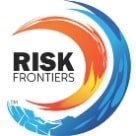Riverine flooding is one of the most costly perils in Australia. The 2023 normalisation of the Insurance Council of Australia Disaster Loss list has riverine flooding contributing over 22% of the loss for natural disasters in Australia. The National Flood Information Database (NFID) shows that over one million addresses have some level of flood risk in Australia.
With climate change the risk from riverine flooding is likely to exacerbate. The frequency and intensity of heavy rainfall events are expected to increase, leading to more frequent and severe flooding. This will have a significant impact on property values and insurance premiums, as well as the cost of rebuilding after a flood.
Risk Frontiers’ riverine flood model, FloodAUS, provides high resolution riverine flood modelling and data to determine the return period of floodwater depth at individual addresses in Australia for over 500,000 unique simulated events. Building on our recognised expertise in developing and managing the National Flood Information Database (NFID) for the Insurance Council of Australia, peer reviewed research and on-the-ground post-event surveys, FloodAUS 4.0 has national coverage for modelling the impact of floods on property and businesses.
FloodAUS Model Overview
FloodAUS is Risk Frontiers’ riverine flood loss model for Australian property exposures that incorporates the latest flood studies, research and expertise.
It is a probabilistic loss model which incorporates high resolution flood modelling and data to represent the hazard as the average annual probability of floodwater depth at individual addresses in hazard as the average annual probability of floodwater depth at individual addresses in Australia. The data source for the hazard is the NFID, which is described below. Risk Frontiers’ internal flood data collection and handling is used to supplement NFID where required. Catchment correlations are incorporated using over 100 years of historical rain gauge data. For the vulnerability a semi-empirical approach has been used, using a combination of empirical derived vulnerability curves from engineering studies and insurance claims data.
FloodAUS Features
NFID & FEZ
Risk Frontiers and Willis Re Australia developed the National Flood Information Database (NFID) for the ICA, covering 13.4 million addresses with detailed flood risk data, including Flood Exclusion Zones for lower-risk areas. FloodAUS uses this dataset as its hazard basis.
Catchment Correlations
Regional rainfall patterns mean flooding between catchments is interdependent. FloodAUS uses cross-catchment correlations to estimate the probability and magnitude of flooding in one catchment based on another within a one-week window.
Vulnerability
Risk Frontiers offers a suite of flood vulnerability functions to assess damage from riverine flood events. These detailed curves, based on empirical data and insurance claims, represent insured loss across various business lines, building types, and coverages, including building, contents, and business interruption.
Who can utilise FloodAUS?
Insurers/Reinsurers
FloodAUS can assist both insurance and reinsurance companies in setting premiums for insurance and re-insurance policies associated with riverine floods. It can also be used to find accumulations of excessive risk.
Emergency Response
FloodAUS has found uses for long term planning and resource allocation for emergency management and emergency response organisations.
Government
Because FloodAUS output can give economic loss estimates it provides a useful tool to government for informing policy settings as well as directing finite resources to areas that will have the most benefit.
FloodAUS Technical Specifications
Hazard Resolution | GNAF point-address level |
Exposure Resolution | Location Address Level |
Event Catalogue | 50,000 years of stochastic flood data derived from NFID and Risk Frontiers’ own aggregation and acquisition of definitive flood data |
Line of Business | Residential / Commercial / Industrial |
Business Interruption | Residential ALE / Commercial BI / Industrial BI |
Coverage | All properties on mainland Australia and Tasmania. Utilises G-NAF. |

James O’Brien, Chief Geospatial Scientist
Learn More About FloodAUS
Get the opportunity to speak with the team who developed the FloodAUS model.
Briefing Notes
Read our latest research
Delve into the insightful articles on climate risk and resilience from the team of risk scientists at Risk Frontiers.
Hurricane Helene: The significance and destruction
Hurricane Helene: The significance and destruction Jacob Evans, Risk Frontiers Hurricane Helene was the strongest hurricane (tropical cyclone) on record to strike the Big Bend
How much longer will the Muswellbrook earthquake swarm last
How much longer will the Muswellbrook earthquake swarm last Paul Somerville The ongoing Muswellbrook earthquake swarm (Risk Frontiers, 2024, Briefing Note 503) has now continued
A Wild and Windy end to Winter 2024
A Wild and Windy end to Winter 2024 Stuart Browning During the last week of August and into early September, Southern Australia experienced a prolonged
